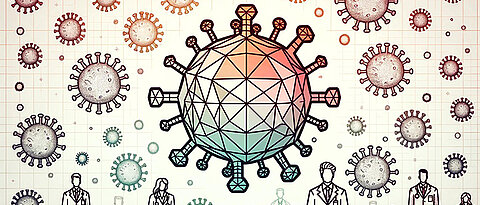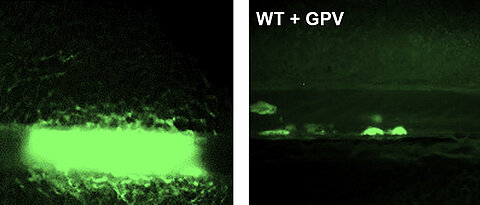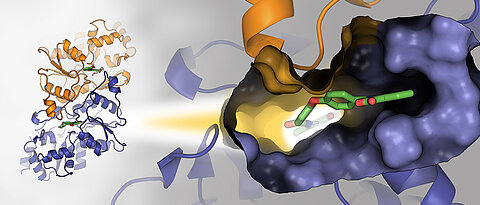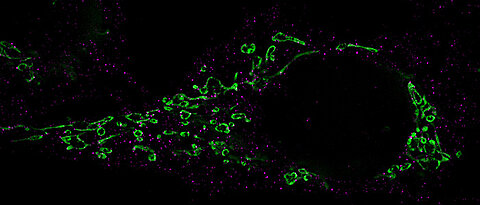
The penetration of viruses into cells can now be tracked with unprecedented accuracy thanks to Würzburg researchers and their innovative design for pseudoviruses.
more
The penetration of viruses into cells can now be tracked with unprecedented accuracy thanks to Würzburg researchers and their innovative design for pseudoviruses.
more
The glycoprotein V of the blood platelets is an important switch point for haemostasis and thrombus formation. This new finding could have great clinical potential.
more
Increased cell proliferation is a key feature of diseases such as cancer. A research team from the University of Würzburg and two Leibniz Institutes has now succeeded in indirectly influencing this process.
more
Researchers at the University of Würzburg develop the "photoswitching fingerprint analysis". A unique technology that for the first time allows the analysis of molecular processes and the regulation of individual proteins in living cells with sub-10 nm spatial resolution. The application ranges from biological to medical research and has been published in the renowned journal Nature Methods.
more
Dormant herpesviruses induce their reactivation via a previously unknown cellular mechanism mediated by a viral microRNA. Würzburg researchers show this in the journal "Nature".
more
Cerebral venous thrombosis is a rare, often severe disease that has been brought to public attention by the Covid 19 pandemic. A research group from Würzburg has now succeeded for the first time in deciphering a molecular cause of this disease. This opens the way to new therapeutic approaches. Published in Nature Cardiovascular Research.
more
An international team of scientists developed a new method and visualized specific receptor proteins in nerve cells that are important for learning. The results were published in the renowned journal Nature Communications.
more
Their work is most frequently cited in publications of other scientists. Four researchers from the University are therefore included in the Highly Cited Researchers 2021 List.
more
Scientists can now see how most proteins fit together in higher organisms. This information has been made freely available online.
more
The RVZ, like Rudolf Virchow, is celebrating an anniversary this year - it has been there for 20 years! From the very beginning, we have been engaged in thematically broad cutting-edge research.
more![[Translate to Englisch:] [Translate to Englisch:]](/fileadmin/_processed_/2/e/csm_G.Beliu_Labor_2a_1a548bb8b1.jpg)
Dr. Gerti Beliu has started a new research group at the Rudolf Virchow Center of the University of Würzburg in September. He uses novel techniques to exploit the resolution of microscopy more effectively and to develop new applications for biomedicine.
more
Professor David Stegner recently accepted the professorship of Vascular Imaging at the Rudolf Virchow Center. With his group, he studies the interactions of blood platelets with immune cells and how these affect inflammatory processes such as stroke.
more
As part of the "Highlights of Physics", Dr. Sebastian Bothe from the RVZ introduced interested students to the methodology of X-ray crystallography.
more
Poxviruses have found a unique way of translating their genes into proteins in the infected organism. A team of researchers from Würzburg shows for the first time how the molecular machinery involved works at an atomic level.
more
Soap molecules reversibly open specific channel proteins in bacteria. These channels are part of the defense mechanisms of bacteria and therefore of relevance to the medical field. A Würzburg research group published these results in the renowned journal PNAS.
more